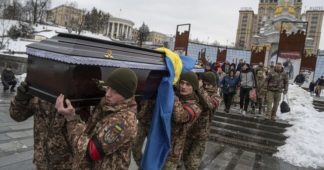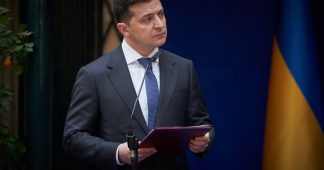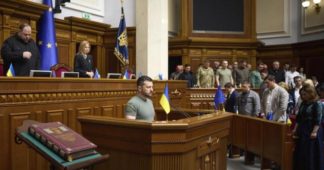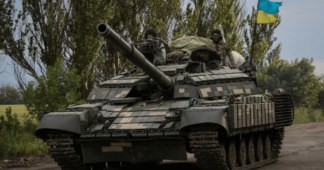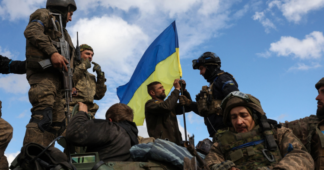By Jason Melanovski
30 December 2023
The government of President Volodymyr Zelensky submitted a new mobilization draft law to parliament on Monday, December, 25 as it seeks to conscript up to 500,000 new troops to continue the NATO proxy war with Russia.
Details on the bill are being purposefully kept under wraps to avoid popular backlash. However, journalists from the news outlet Hromadske were able to download an explanatory description before the Ukrainian parliament’s website was shut down to public access. Among the proposed changes are:
- The conscription age is to be lowered from 27 to 25 years;
- The introduction of basic three-months-long military training for all Ukrainian citizens aged 18 to 25 in every educational establishment;
- The introduction of optional military service for persons aged under 25 who were not able to complete basic military training;
- Restrictions on Ukrainian citizens who evade registering with a military enlistment office and completing military service;
- Administrative service centres and employment and recruitment centres are to be involved in military recruitment.
The draft law also proposes to deliver military call-up notices via email and an online service for conscripts, persons liable for military service and reservists.
Among the controversial aspects of the bill are proposals to cancel the passports of Ukrainians living abroad who refuse to report for mobilization, thus threatening their legal status within the country they currently reside. Following the announcement of the proposal, Ukrainians across Europe were seen waiting in line at consular offices to renew their passports before the mobilization changes take effect. In Valencia, Spain, 550 people reportedly waited in line for hours to renew their passports and ensure their legal status for the upcoming year in Spain.
The Ukrainian parliament is set to review the new mobilization rules, followed by a vote that will likely take place as early as mid-January 2024. According to reports, members of Zelensky’s Servant of the People party have been told not to publicly discuss any details of the bill.
Zelensky first announced the proposal in his end of the year press conference on December 19, making headlines both in Ukraine and internationally. The half a million additional troops are to be mobilized at a cost of $13.3 billion. Zelensky claimed at the time that the proposal was made in response to a request from Armed Forces Commander General Valery Zaluzhnyi, with whom Zelensky has waged a very public political struggle over the direction of the war. Yet Zaluzhnyi promptly declared on December 26 that he and the army leadership had never submitted a request for a specific number of troops to be mobilized, directly contradicting the president and his justification for the mobilization bill.
The new mobilization bill is testimony to the state of extreme crisis of the war and the Ukrainian oligarchic regime as a whole. It also demonstrates that, amidst this crisis, the ruling class is prepared to sacrifice hundreds of thousands, if not millions more, for the war against Russia. However, not only the funding of this mobilization effort but also its physical feasibility are in serious question.
Given that Ukraine had a pre-war population of approximately 36 million, the proposed numbers represent a huge share of the working age population forced into NATO’s proxy war that has failed to achieve any of the stated objectives of the Ukrainian government or NATO. The percentage is even larger if one considers that millions have fled the country and many more live in territories not controlled by the Zelensky government.
BBC Ukraine reported in November that 650,000 Ukrainian men aged 18-60 have left Ukraine for other countries in Europe since the start of the war. Zelensky’s former advisor Alexey Arestovich recently claimed that 4.5 million Ukrainian men, nearly half of the Ukrainian male population, had fled abroad to avoid military service and that 30 to 70 percent of military units consist of “refuseniks” who have gone AWOL (absent without official leave).
Out of the remaining population, hundreds of thousands have already been killed, with even Zelensky’s former advisor, Alexey Arestovich putting the number of estimated dead at a staggering 400,000. Given that there are an average of 3 wounded per 1 dead soldier, the number of those injured must now be well over 1 million. At least 80,000 people have become amputees.
Meanwhile, Zaluzhnyi himself acknowledged in November in the Economist that the war had reached a “stalemate”, drawing the ire of Zelensky who shortly thereafter cancelled the planned 2024 presidential elections. Confronting a severe shortage of men at the front throughout the past year, the Ukrainian military has resorted to kidnapping people off the streets, grabbing them at shopping malls and other public places, and forcibly drafting them into the army.
Roman Kostenko, a Ukrainian parliament member and secretary of Ukraine’s parliamentary security committee recently told the news outlet Ukrinform, that “the words about an additional 450,000-500,000 mobilized have become a cold shower for everyone”. He added that the military must be replenished due to losses as the war “can… drag on for a long time.”
Zelensky and the Ukrainian ruling class as a whole are clearly aware that the a new round of mass mobilization would prove unpopular as the war drags on and the casualties continue to rise. In an embryonic but significant expression of growing anti-war sentiment, this fall saw the first nationwide protests by family members of soldiers, some of whom have been deployed at the front since the start of the war in February 2022 almost two years ago.
Zelensky has called the proposal “a very sensitive issue” and attempted to offload much of the responsibility onto parliament and the military with Zaluzhnyi as its leader and public face.
The fact that the bill was introduced on Christmas Day which Ukrainian Orthodox Christians were busy celebrating for the first time ever on December 25 was clearly an attempt to avoid popular uproar. Previously, Orthodox Christians in Ukraine celebrated Christmas on January 7th as in Russia, but the date was changed this year by the newly-formed Orthodox Church of Ukraine in cooperation with the right-wing government in a xenophobic and reactionary attempt to divide the Ukrainian working class along religious lines.
There are also fears within the government and ruling class that the law is too open an admission of the catastrophic state of the war. Statements by Oleksandr Musienko, the head of the Center of Military Law Studies NGO, indicate that sections of the Ukrainian ruling class view the new mobilization law as a sign of panic and desperation on the part of Zelensky.
“The aggressor (Russia) can rejoice to some extent,” Musienko told the New Voice of Ukraine radio this week. “I don’t understand why [this bill was introduced]. The situation in our state is not fatal or catastrophic. They monitor and interpret it as if panic has somehow leaked through to us, and our decision-making is influenced not by rational calculations but by a panicked reaction.”
“I get the feeling that someone consciously, intentionally, or unintentionally (through certain erroneous actions) aims to discredit the mobilization campaign in Ukraine, which is very, very dangerous.”
The mobilization draft law was announced amidst a new round of provocative strikes by Ukraine in Crimea on Tuesday. Satellite images showed significant damage to the Russian tank landing ship Novocherkassk, which Ukraine claims to have destroyed in a cruise missile attack. A part of Russia’s Black Sea Fleet, the ship carries a crew of around 87 with capacity for 237 troops, according to the US military.
While the Ukrainian military and press made much of the attack, the operation was timed in order to divert attention from the news that Ukrainian forces had lost the city of Marinka in the eastern Donetsk region — yet another territorial loss for Ukraine which even the New York Times was forced to report.
We remind our readers that publication of articles on our site does not mean that we agree with what is written. Our policy is to publish anything which we consider of interest, so as to assist our readers in forming their opinions. Sometimes we even publish articles with which we totally disagree, since we believe it is important for our readers to be informed on as wide a spectrum of views as possible.
